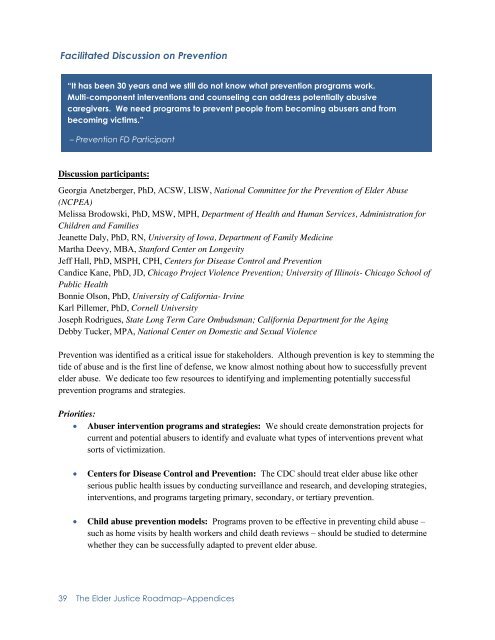The Elder Justice Roadmap
2gJRXoo
2gJRXoo
You also want an ePaper? Increase the reach of your titles
YUMPU automatically turns print PDFs into web optimized ePapers that Google loves.
Facilitated Discussion on Prevention<br />
“It has been 30 years and we still do not know what prevention programs work.<br />
Multi-component interventions and counseling can address potentially abusive<br />
caregivers. We need programs to prevent people from becoming abusers and from<br />
becoming victims.”<br />
– Prevention FD Participant<br />
Discussion participants:<br />
Georgia Anetzberger, PhD, ACSW, LISW, National Committee for the Prevention of <strong>Elder</strong> Abuse<br />
(NCPEA)<br />
Melissa Brodowski, PhD, MSW, MPH, Department of Health and Human Services, Administration for<br />
Children and Families<br />
Jeanette Daly, PhD, RN, University of Iowa, Department of Family Medicine<br />
Martha Deevy, MBA, Stanford Center on Longevity<br />
Jeff Hall, PhD, MSPH, CPH, Centers for Disease Control and Prevention<br />
Candice Kane, PhD, JD, Chicago Project Violence Prevention; University of Illinois- Chicago School of<br />
Public Health<br />
Bonnie Olson, PhD, University of California- Irvine<br />
Karl Pillemer, PhD, Cornell University<br />
Joseph Rodrigues, State Long Term Care Ombudsman; California Department for the Aging<br />
Debby Tucker, MPA, National Center on Domestic and Sexual Violence<br />
Prevention was identified as a critical issue for stakeholders. Although prevention is key to stemming the<br />
tide of abuse and is the first line of defense, we know almost nothing about how to successfully prevent<br />
elder abuse. We dedicate too few resources to identifying and implementing potentially successful<br />
prevention programs and strategies.<br />
Priorities:<br />
Abuser intervention programs and strategies: We should create demonstration projects for<br />
current and potential abusers to identify and evaluate what types of interventions prevent what<br />
sorts of victimization.<br />
<br />
Centers for Disease Control and Prevention: <strong>The</strong> CDC should treat elder abuse like other<br />
serious public health issues by conducting surveillance and research, and developing strategies,<br />
interventions, and programs targeting primary, secondary, or tertiary prevention.<br />
Child abuse prevention models: Programs proven to be effective in preventing child abuse –<br />
such as home visits by health workers and child death reviews – should be studied to determine<br />
whether they can be successfully adapted to prevent elder abuse.<br />
39 <strong>The</strong> <strong>Elder</strong> <strong>Justice</strong> <strong>Roadmap</strong>–Appendices


